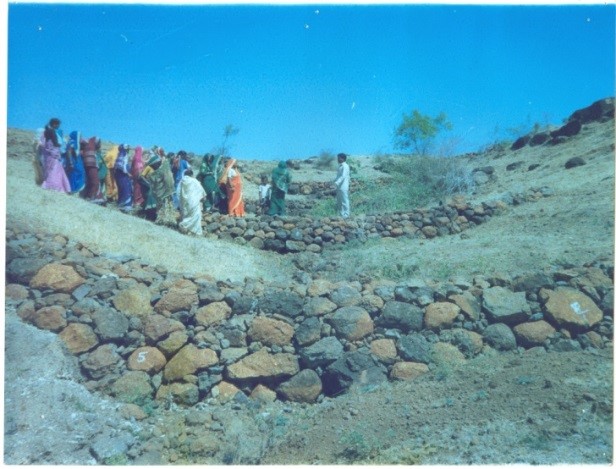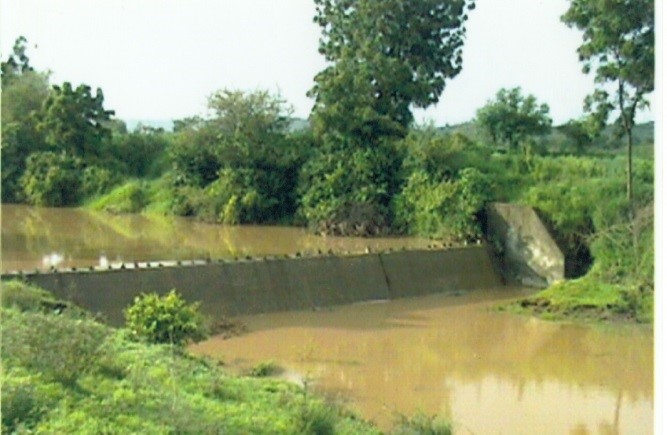Building resilience to climate change in rural India
Why integrated watershed management?
Rural communities throughout India are struggling with the realities of increasing climatic variability and climate change together with declining farm productivity and the rising cost of cultivation associated with depleting and degrading natural resources. India is especially vulnerable to climate change, given the dependence of its dense population on agriculture, excessive pressure on natural resources and poor coping capabilities. The anticipated impact of climate change is likely to lead to increased pressure on already scarce land and water resources. Integrated watershed management (IWSM), rooted in the principle of ecosystem-based approaches, has been broadly adopted in India since 1987 for the conservation, sustainable use and regeneration of natural resources, like land and water, in order to enhance livelihoods and resilience [1].
Integrated watershed management – What is it?
IWSM focuses on enhancing natural and social capital in rural areas through a mix of land and water management solutions. These range from in-situ moisture conservation, capturing and storing rainwater, and enhancing groundwater recharge to soil health management, agroforestry and livelihood support for sustainable agricultural development [1] [2] [3]. Effective IWSM is contingent on integrating the physical, biological, social and economic sciences with adopted practices and infrastructure to address growing complexity in the management of natural resources. Water is viewed as a critical “entry point” for sustained productivity and livelihoods, and retaining and enhancing subsurface moisture and groundwater storage are key to the success of IWSM in arid and semi-arid parts of India, where most IWSM programs have been implemented.
Key interventions include continuous contour trenching (Figure 1), staggered contour trenching, tree plantations in forests, private and village common lands to provide vegetative cover against soil erosion and land degradation, contour bunding[i] (or field bunding, with a small earthen embankment along the fields), land shaping, check dams (Figures 2 and 3), subsurface barriers, percolation ponds/tanks (Figure 4), and rainwater harvesting ponds/tanks to conserve rainwater and recharge groundwater. Water budgeting, in which farmers keep track of their water use and available water resources, is also increasingly applied. For example, under the technical guidance of the District Groundwater Department, farmers adopted this approach in Hiware Bazar in 2004 through the village council or watershed committee. They measured rainfall and monitored six observation wells, and turned the data into annual water budgets. Farmers also improved demand management by adopting efficient water application methods, like drip irrigation, and by limiting the area under water-demanding crops, like sugarcane and banana. These measures made farm production less vulnerable to droughts and dry years [4].

Figure 1. Continuous contour trenching (photo: B. R. Sharma).

Figure 2. Lose boulder check dam (photo: Kadwanchi project implementers).
Impacts and evidence base for building climate resilience
There is ample evidence in India that nature-based IWSM solutions provide multiple benefits through the conservation of natural resources and enhancement of livelihoods [1] [2] [3] [5]. To provide a comprehensive assessment of watersheds in India, a macro-level evaluation of 636 micro-watersheds was conducted through meta-analysis [2]. The results revealed that watershed programs provide multiple benefits by reducing runoff (by 45%, on average) and soil loss, augmenting groundwater storage, boosting crop yields, increasing cropping intensity (by 36%, on average), enhancing income, generating rural employment, building social capital and reducing poverty [2]. Kadwanchi Watershed (1,888 ha) in Jalana District of Maharashtra under the Indo-German Watershed Development Programme (IGWDP) [3], Hiware Bazar Participatory Watershed Development Model (976 ha) in Ahmednagar District of Maharashtra [6], and Ralegan Siddhi Watershed (982 ha) in Ahmednagar District of Maharashtra [7] are examples of famous and widely acclaimed successful watersheds.
In 2012, the Watershed Organisation Trust (WOTR) implemented a climate change adaptation strategy building on the proven watershed approach [8]. For example, based on early adoption of watershed approaches (from 2002), a few farmers in the Kumbharwadi watershed village of Ahmednagar District of Maharashtra coped with extreme climatic conditions in 2012 by diversifying their cropping systems [8]. This not only minimized the climatic and market risks but also provided diverse and nutritious food at the household level. Watershed development, besides increasing water availability and land productivity, contributed greatly towards enhancing farmers’ ability to manage risk.

Figure 3. Water harvesting check dam (photo: A. Sikka).
The ex-post analysis of Kadwanchi watershed in Jalna District, Maharashtra, found that the average depth to groundwater in open dug wells had decreased from 9.5 m to 6.1 m in the decade or more since implementation. This indicates a rise in the water table of 3.4 m3. It was also observed during the survey in 2012 that out of nine dug wells that went dry before implementation, seven of those were recharged and became fully functional as a result of the interventions. It was also noticed that farmers used water judiciously and managed their cotton crops well even during drought based on water budget calculations. The watershed is now self-sufficient in drinking water and does not depend on tankers for water supply. Participatory ridge-to-valley interventions for soil and water conservation with committed community participation, Village Watershed Committees (VWCs) and Self Help Groups were still in place 10 years after the project ended.
Similar studies examined the impact of six IWSM projects implemented by the Central Soil and Water Conservation Research and Training Institute and its regional centers in the states of Punjab, Madhya Pradesh, Gujarat, Tamil Nadu, Rajasthan and Odisha. The results demonstrated that the natural resource management interventions significantly increased groundwater recharge, irrigated area, and biomass production. This, in turn, enhanced drought resilience, employment generation and the socioeconomic conditions of the local people [5] [9]. For instance, in Saliyur watershed (513 ha) in Coimbatore District of Tamil Nadu, where the average annual rainfall is 602 mm, a total of 26,600 m3 of additional surface water storage capacity was created through micro water resources development (check dams and percolation ponds), which enhanced groundwater recharge. It was observed that the groundwater table rose by up to 1.0 m in the influence zone of the percolation ponds; recharge increased by 10 to 15%; and the duration of water availability in wells after the start of the dry season rose from 3-6 months before watershed interventions to 9-12 months afterwards [9]. Within the influence zone of the percolation ponds, the irrigated area increased from 13.7 ha to 25.1 ha, and farmers diversified from low-value crops to high-value vegetables, thus enhancing local livelihoods. Further research is needed to determine the wider basin-scale hydrological impacts of IWSM approaches, such as the capture of more rain and runoff in upper catchments.

Figure 4. Percolation pond (photo: CSWCRTI Research Center, Ooty)
What’s next?
Watershed management in India, implemented by multiple ministries, departments and agencies, has undergone several paradigm shifts since the mid-1980s [1]. Earlier generations of watershed programs were mostly confined to piecemeal sectoral approaches focused on soil and water conservation. Over the years, emphasis has shifted to participatory and integrated approaches with a stronger focus on productivity enhancement, livelihood security and income generation [1] [2]. The Government of India revised watershed management guidelines in 2008, emphasizing community participation and formation of local people’s institutions, such as Watershed Committees, Self Help Groups and User Groups in planning and implementing watershed projects [10]. The revised guidelines also focus on more spatial integration, as programs work with watersheds encompassing 1,000 to 5,000 ha and comprising clusters of sub- or micro-watersheds, as distinct from the focus of earlier programs on smaller individual watersheds of around 500 to 800 ha.
In July 2015, the national Integrated Watershed Management Programme of the Government of India became a component of the national flagship program, called the Pradhan Mantri Krishi Sinchayee Yojana (Prime Minister’s Irrigation Scheme), with the motto Har Khet Ko Pani (water to every farm). The CGIAR Research Program on Climate Change, Agriculture and Food Security (CCAFS) and Indian Council of Agricultural Research (ICAR) are adopting components of IWSM as part of their effort to promote climate-smart villages [11]. Experience shows that to scale out IWSM successfully requires proper facilitation by the implementing agency, transparency in implementation, active participation by the community, and convergence between related development initiatives.
[i] Miniature earthen barriers or embankments on contours (across the slope) at certain vertical intervals on cultivated land for soil and moisture retention and conservation.
[1] Sharda, V.N.; Sikka, A.K.; Juyal, G.P. 2012. Participatory integrated watershed management: A field manual. Dehradun, India: Central Soil and Water Conservation Research and Training Institute (CSWCRTI).
[2] Joshi, P.K.; Jha, A.K.; Wani Suhas, P.; Sreedevi, T.K.; Shaheen, F.A. 2008. Impact of watershed program and conditions for success: A meta-analysis approach. Global Theme on Agroecosystems Report no. 46. Patancheru, Andhra Pradesh, India: International Crops Research Institute for the Semi-Arid Tropics. 24p.
[3] Osman, M.; Sonune, S.V.; Shankar, K.R.; Ravi, D.; Pandit, W. 2013. Impact evaluation of Kadwanchi watershed in Maharashtra: Lessons for post-project sustainability. Indian Journal of Dryland Agricultural Research and Development 28(2): 9-15.
[4] GSDA (Groundwater Surveys and Development Agency). Artificial recharge to ground water in Hivre Bazar, Tal/Dist. Ahmednagar, (Nashik region). https://gsda.maharashtra.gov.in/english/admin/PDF_Files/1496645367_Artificial_Recharge-Hivare_Bazar-Anagar.pdf
[5] Sharda, V.N.; Samra, J.S.; Pradeep, D. 2005. Participatory watershed management programmes for sustainable development: Experiences from Integrated Watershed Development Program (IWDP). Indian Journal of Soil and Water Conservation 33(2): 93-103.
[6] Singh, S. 2010. Enhancing agriculture by ecosystem management in Hiware Bazar, India. www.TEEBweb.org.
[7] Narayana, N.V.; Prahalladiah, S. 1999. COWDEP – A boon to drought prone areas. Kurukshetra 47(3): 305.
[8] Gray, E.; Srinidhi, A. 2013. Watershed development in India: Economic valuation and adaptation considerations. Working Paper. Washington, DC: World Resources Institute.
[9] Sikka, A. K.; Madhu, M.; Chand, S.; Singh, D.V.; Selvi, V.; Jeevarathanam, K.; Murgaiah, M. 2014. Impact analysis of participatory integrated watershed management programme in semi-arid region of Tamil Nadu, India. Indian Journal of Soil and Water Conservation 42(1): 98-106.
[10] Government of India. (2008, 2011). Common guidelines for watershed management projects. New Delhi, India: National Rainfed Area Authority, Planning Commission.
[11] Sikka, A.K.; Islam, A.; Rao, K.V. 2018. Climate-smart land and water management for sustainable agriculture. Irrigation and Drainage 67(1): 72-81.
Alok K. Sikka1, Paul Pavelic2 and Karen G. Villholth3
1 International Water Management Institute (IWMI), India; Email: a.sikka@cgiar.org
2 IWMI, Lao PDR
3 IWMI, South Africa





































